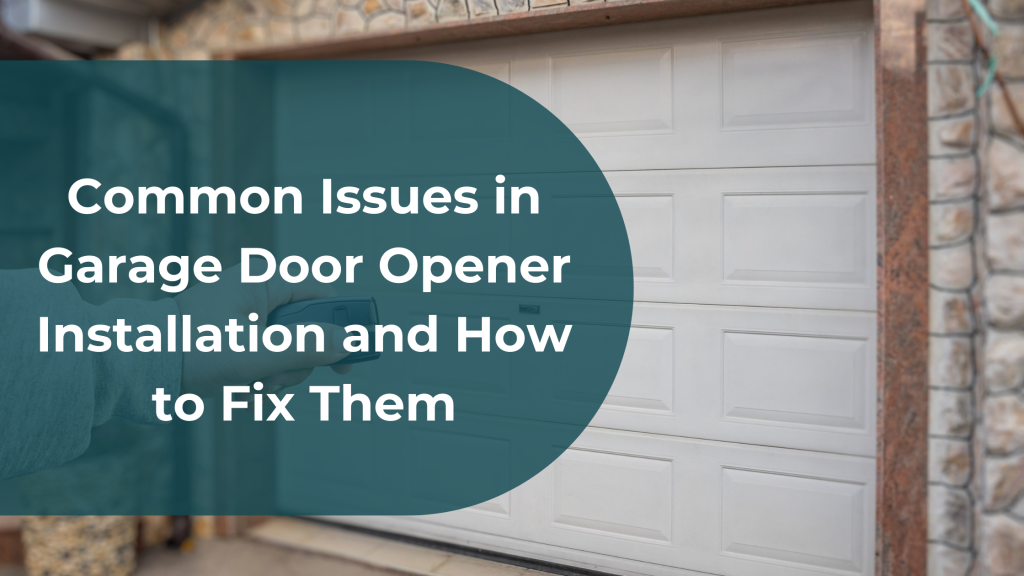Introduction to Garage Door Opener Installation
A functioning garage door opener adds convenience, security, and efficiency to any home. However, the process of garage door opener installation can be challenging, especially for homeowners attempting it without prior experience. While many guides online explain how to garage door opener installation, the process involves electrical wiring, mechanical adjustments, and precise alignment. Any mistake can cause the system to malfunction, leading to inconvenience or even safety hazards.
That is why many people choose professional garage door opener installation. Experts not only save time but also ensure the job is completed correctly. Still, whether you are doing it yourself or working with a contractor, it helps to understand the common issues that occur during installation and how to fix them.
Tools and Materials Required
Proper installation begins with having the right tools and materials. Missing or inadequate tools often lead to mistakes and longer installation times.
Essential tools include:
- Power drill with appropriate bits
- Adjustable wrench and socket set
- Screwdrivers (flathead and Phillips)
- Pliers and locking clamps
- Level for proper alignment
- Ladder for safe access to ceiling mounts
- Measuring tape and pencil for marking
- Safety goggles and gloves
Common materials include:
- Garage door opener unit
- Mounting brackets and rails
- Fasteners and bolts (supplied with the unit)
- Safety sensors and wiring
- Power cords and extension (if necessary)
Professionals arrive with all the right tools, which reduces the chance of errors. For DIY homeowners, ensuring you have these items ready will make the process smoother.
Step-by-Step Instructions
While instructions vary depending on the brand and model, the typical installation process follows these steps:
- Assemble the Opener Rail: Attach the rail to the motor unit as directed by the manual.
- Mount the Rail to the Header Bracket: Secure the rail above the garage door.
- Install the Motor Unit: Position and secure the opener to the ceiling with mounting brackets.
- Attach the Belt or Chain: Connect the drive system between the motor and the door arm.
- Install Safety Sensors: Place sensors near the floor, aligned with each other to detect obstructions.
- Connect to Power Source: Plug in the opener or wire it to the electrical system.
- Test the Door: Ensure the door opens and closes smoothly without jerking or uneven movement.
Even when following these steps, issues can arise, such as misaligned rails, improper sensor installation, or faulty wiring.
Safety Tips and Best Practices
Working with garage doors involves risks because of the heavy door weight, electrical wiring, and moving parts. Following safety precautions reduces the chance of injury and damage.
- Disconnect Power First: Always turn off power before working on wiring.
- Secure the Door: Make sure the garage door is fully closed and clamped before installation.
- Follow Weight Capacity: Use an opener rated for the size and weight of your garage door.
- Check Sensor Alignment: Misaligned safety sensors can prevent the door from closing.
- Avoid Loose Bolts: Ensure all mounting brackets and fasteners are tightly secured.
- Test Safety Features: Verify that auto-reverse functions work correctly to prevent accidents.
A professional garage door opener installation service ensures these safety steps are followed. Trained technicians can also troubleshoot hidden issues that a DIY installer might miss.
Final Thoughts and Maintenance Tips
Installing a garage door opener can be a rewarding project, but it comes with challenges. From misaligned tracks to faulty sensors, small mistakes can cause major problems. Understanding the process, having the right tools, and following safety practices help, but professional services offer reliability and peace of mind.
To keep your opener functioning properly after installation:
- Lubricate Moving Parts: Apply lubricant to chains, rollers, and hinges regularly.
- Inspect Sensors: Check alignment often to prevent operational issues.
- Tighten Hardware: Vibrations can loosen nuts and bolts over time.
- Test Backup Power: If your unit has battery backup, confirm it works during outages.
- Schedule Professional Inspections: An annual check can catch problems before they become costly repairs.
In conclusion, whether you choose DIY or hire professionals, knowing the common issues in garage door opener installation helps you maintain a safe and efficient system. While learning how to garage door opener installation can be useful, expert help ensures durability and long-term reliability.



